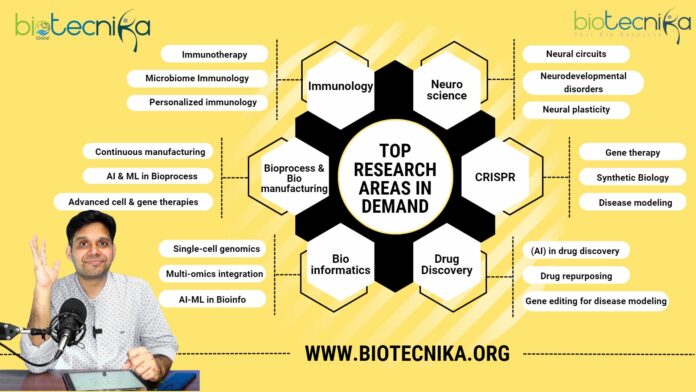Top Research Areas In Demand – 120+ Experts’ Analyses For the Future
As science and technology continue to evolve, the demand for research in specific areas continues to rise. These areas are identified as top research areas and have been attracting the attention of scientists, researchers, and investors alike. In this article, we will explore the top research areas in demand as analyzed by over 120 experts, and their potential impact on the future.
- CRISPR – (Gene Therapy, Synthetic Biology, Disease Modeling)
CRISPR (Clustered Regularly Interspaced Short Palindromic Repeats) is a revolutionary technology that allows scientists to edit genes with unprecedented accuracy and ease. The potential applications of CRISPR are vast, and they range from curing genetic diseases to creating designer babies.
Gene therapy is one of the most promising applications of CRISPR. By using CRISPR, scientists can remove or replace faulty genes responsible for genetic diseases. CRISPR can also be used to create synthetic biology, where scientists can engineer organisms to produce valuable compounds like medicines or biofuels. Disease modeling is another promising application of CRISPR, where scientists can create animal models of human diseases to better understand their biology and develop new treatments.
- Drug Discovery- (AI in Drug discovery, Drug re-purposing, gene editing for disease modeling)
The process of drug discovery can be time-consuming, expensive, and often results in failure. However, with the advent of AI and machine learning, the process has become more efficient and effective.
AI in drug discovery involves the use of algorithms to predict the efficacy of drugs and their potential side effects. This technology has the potential to revolutionize the drug discovery process by speeding up drug development and reducing costs. Drug re-purposing is another area of research in drug discovery that involves the use of existing drugs for new therapeutic purposes. This approach is cost-effective and can lead to the discovery of new treatments for diseases.
Gene editing for disease modeling is another area of research in drug discovery. By using CRISPR, scientists can create animal models of human diseases to better understand the underlying biology of the disease and develop new treatments.
- Bioinformatics – (Single cell genomics, multi omics integration, AI-ML in Bioinfo)
Read More: Can Bioinformatics Offer a Lucrative / High Salary Career for Biologists?
Bioinformatics is an interdisciplinary field that combines biology, computer science, and statistics to analyze and interpret biological data. The field is growing rapidly, and there is a high demand for skilled professionals in this area.
Single cell genomics is a relatively new area of research in bioinformatics that involves the study of individual cells. This technology has the potential to revolutionize our understanding of cell biology and disease.
Multi-omics integration is another area of research in bioinformatics that involves the integration of data from multiple omics platforms, such as genomics, transcriptomics, and proteomics. This approach can lead to a more comprehensive understanding of complex biological systems.
AI-ML in bioinformatics is an area of research that involves the use of machine learning algorithms to analyze large amounts of biological data. This technology has the potential to revolutionize the field by speeding up data analysis and reducing errors.
- Bio process & Bio manufacturing – (Continuous manufacturing, AI & ML in bioprocess, Advanced Cell and Gene therapies)
Bio process and bio manufacturing are critical components of the biotechnology industry. These processes involve the use of living organisms or their products to produce valuable compounds like medicines, biofuels, or chemicals.
Continuous manufacturing is an area of research in bio process and bio manufacturing that involves the use of continuous flow reactors instead of batch reactors. This approach can lead to increased efficiency and reduced costs.
AI and ML in bioprocess are also areas of research in bio process and bio manufacturing. These technologies can be used to optimize fermentation conditions and reduce waste, leading to increased efficiency and reduced costs.
Advanced cell and gene therapies are another area of research in bio process and bio manufacturing. These therapies involve the use of cells or genes to treat or prevent disease. The development of advanced cell and gene therapies requires the optimization of bioprocesses and the use of advanced technologies like CRISPR.
- Immunology – (Immunotherapy, Microbiome Immunology, Personalized Immunology)
Immunology is the study of the immune system and its role in defending the body against disease. This field of research has been growing rapidly in recent years, driven by advances in technologies like gene editing and immunotherapy.
Immunotherapy is a type of cancer treatment that involves the use of the body’s own immune system to fight cancer. This approach has shown promising results in clinical trials and has the potential to revolutionize cancer treatment.
Microbiome immunology is another area of research in immunology that involves the study of the interactions between the microbiome and the immune system. This area of research has the potential to lead to new treatments for autoimmune diseases and other immune-related disorders.
Personalized immunology is an area of research that involves tailoring immunotherapy to an individual’s specific genetic and immune profile. This approach has the potential to improve the efficacy of immunotherapy and reduce the risk of side effects.
- Neuroscience – (Neuro circuits, Neurodevelopmental disorders, neural plasticity)
Neuroscience is the study of the nervous system and its role in regulating behavior and cognition. This field of research has been growing rapidly in recent years, driven by advances in technologies like brain imaging and gene editing.
Neuro circuits are networks of neurons that are responsible for specific behaviors or cognitive functions. The study of these circuits has the potential to lead to new treatments for neurological disorders like Parkinson’s disease and schizophrenia.
Neurodevelopmental disorders are a group of disorders that affect the development of the nervous system. The study of these disorders has the potential to lead to new treatments for conditions like autism and ADHD.
Neural plasticity is the ability of the brain to change and adapt in response to new experiences. The study of neural plasticity has the potential to lead to new treatments for neurological disorders and to improve cognitive function in healthy individuals.
Conclusion
In conclusion, the top research areas in demand are diverse and wide-ranging. These areas are driven by advances in technologies like CRISPR, AI, and machine learning, and have the potential to revolutionize our understanding of biology and disease. The research being conducted in these areas has the potential to lead to new treatments for diseases, improved manufacturing processes, and a better understanding of the human body and mind. As the field of science and technology continues to evolve, it is likely that new areas of research will emerge, and our understanding of the world around us will continue to expand.




































